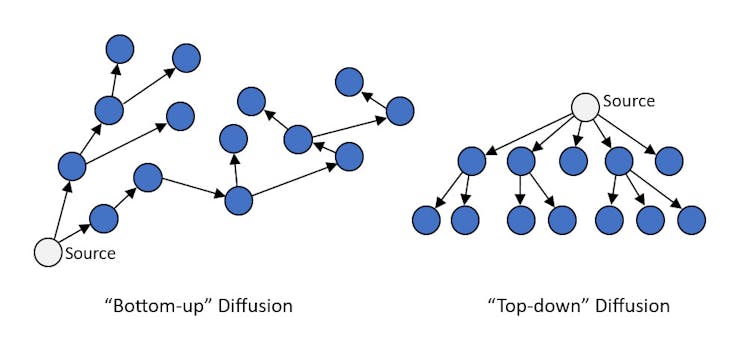Most of us still call them UFOs – unidentified flying objects. NASA recently adopted the term "unidentified anomalous phenomena," or UAP. Either way, every few years popular claims resurface that these things are not of our world, or that the U.S. government has some stored away.
I'm a sociologist who focuses on the interplay between individuals and groups, especially concerning shared beliefs and misconceptions. As for why UFOs and their alleged occupants enthrall the public, I've found that normal human perceptual and social processes explain UFO buzz as much as anything up in the sky.
Historical context
Like political scandals and high-waisted jeans, UFOs trend in and out of collective awareness but never fully disappear. Thirty years of polling find that 25%-50% of surveyed Americans believe at least some UFOs are alien spacecraft. Today in the U.S., over 100 million adults think our galactic neighbors pay us visits.
It wasn't always so. Linking objects in the sky with visiting extraterrestrials has risen in popularity only in the past 75 years. Some of this is probably market-driven. Early UFO stories boosted newspaper and magazine sales, and today they are reliable clickbait online.
Despite the growing interest, multiple investigations have found no evidence that UFOs are of extraterrestrial origin
In 1980, a popular book called "The Roswell Incident" by Charles Berlitz and William L. Moore described an alleged flying saucer crash and government cover-up 33 years prior near Roswell, New Mexico. The only evidence ever to emerge from this story was a small string of downed weather balloons. Nevertheless, the book coincided with a resurgence of interest in UFOs. From there, a steady stream of UFO-themed TV shows, films, and pseudo-documentaries has fueled public interest. Perhaps inevitably, conspiracy theories about government cover-ups have risen in parallel.
Some UFO cases inevitably remain unresolved. But despite the growing interest, multiple investigations have found no evidence that UFOs are of extraterrestrial origin – other than the occasional meteor or misidentification of Venus.
But the U.S. Navy's 2017 Gimbal video continues to appear in the media. It shows strange objects filmed by fighter jets, often interpreted as evidence of alien spacecraft. And in June 2023, an otherwise credible Air Force veteran and former intelligence officer made the stunning claim that the U.S. government is storing numerous downed alien spacecraft and their dead occupants.
UFO videos released by the U.S. Navy, often taken as evidence of alien spaceships.
Human factors contributing to UFO beliefs
Only a small percentage of UFO believers are eyewitnesses. The rest base their opinions on eerie images and videos strewn across both social media and traditional mass media. There are astronomical and biological reasons to be skeptical of UFO claims. But less often discussed are the psychological and social factors that bring them to the popular forefront.
Many people would love to know whether or not we're alone in the universe. But so far, the evidence on UFO origins is ambiguous at best. Being averse to ambiguity, people want answers. However, being highly motivated to find those answers can bias judgments. People are more likely to accept weak evidence or fall prey to optical illusions if they support preexisting beliefs.
We've heard this sort of thing before, along with promises that the proof will soon be revealed. But it never comes
For example, in the 2017 Navy video, the UFO appears as a cylindrical aircraft moving rapidly over the background, rotating and darting in a manner unlike any terrestrial machine. Science writer Mick West's analysis challenged this interpretation using data displayed on the tracking screen and some basic geometry. He explained how the movements attributed to the blurry UFO are an illusion. They stem from the plane's trajectory relative to the object, the quick adjustments of the belly-mounted camera, and misperceptions based on our tendency to assume cameras and backgrounds are stationary.
West found the UFO's flight characteristics were more like a bird's or a weather balloon's than an acrobatic interstellar spacecraft. But the illusion is compelling, especially with the Navy's still deeming the object unidentified.
West also addressed the former intelligence officer's claim that the U.S. government possesses crashed UFOs and dead aliens. He emphasized caution, given the whistleblower's only evidence was that people he trusted told him they'd seen the alien artifacts. West noted we've heard this sort of thing before, along with promises that the proof will soon be revealed. But it never comes.
Anyone, including pilots and intelligence officers, can be socially influenced to see things that aren't there. Research shows that hearing from others who claim to have seen something extraordinary is enough to induce similar judgments. The effect is heightened when the influencers are numerous or higher in status. Even recognized experts aren't immune from misjudging unfamiliar images obtained under unusual conditions.
Group factors contributing to UFO beliefs
"Pics or it didn't happen" is a popular expression on social media. True to form, users are posting countless shaky images and videos of UFOs. Usually they're nondescript lights in the sky captured on cellphone cameras. But they can go viral on social media and reach millions of users. With no higher authority or organization propelling the content, social scientists call this a bottom-up social diffusion process.
In contrast, top-down diffusion occurs when information emanates from centralized agents or organizations. In the case of UFOs, sources have included social institutions like the military, individuals with large public platforms like U.S. senators, and major media outlets like CBS.
The left image shows bottom-up diffusion, in which information spreads from person to person. The right shows top-down, in which information spreads from one authority. Barry Markovsky
Amateur organizations also promote active personal involvement for many thousands of members, the Mutual UFO Network being among the oldest and largest. But as Sharon A. Hill points out in her book "Scientifical Americans," these groups apply questionable standards, spread misinformation and garner little respect within mainstream scientific communities.
Top-down and bottom-up diffusion processes can combine into self-reinforcing loops. Mass media spreads UFO content and piques worldwide interest in UFOs. More people aim their cameras at the skies, creating more opportunities to capture and share odd-looking content. Poorly documented UFO pics and videos spread on social media, leading media outlets to grab and republish the most intriguing. Whistleblowers emerge periodically, fanning the flames with claims of secret evidence.
Despite the hoopla, nothing ever comes of it.
For a scientist familiar with the issues, skepticism that UFOs carry alien beings is wholly separate from the prospect of intelligent life elsewhere in the universe. Scientists engaged in the search for extraterrestrial intelligence have a number of ongoing research projects designed to detect signs of extraterrestrial life. If intelligent life is out there, they'll likely be the first to know.
As astronomer Carl Sagan wrote, "The universe is a pretty big place. If it's just us, seems like an awful waste of space."
Barry Markovsky, Distinguished Professor Emeritus of Sociology, University of South Carolina
This article is republished from The Conversation under a Creative Commons license. Read the original article.


Shares